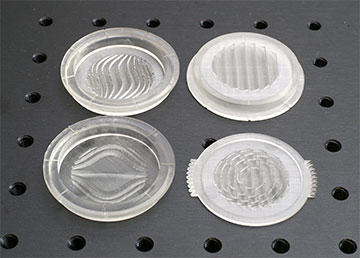![]()
Researchers in Hong Kong have shown how the relative rotation of different metasurfaces fabricated using 3D printing can focus terahertz radiation to arbitrary points on a 2D plane or in 3D space. [Image: J.C. Zhang et al., Sci. Adv., doi: 10.1126/sciadv.adf8478; CC BY-NC 4.0]
Sixth-generation wireless communication (6G) promises to provide far speedier data transmission than the 5G systems currently being introduced around the world, thanks largely to the use of higher frequency terahertz radiation. But that radiation is quite easily attenuated as it travels through air, prompting the need for new technology to precisely steer data to their intended recipients.
Now researchers in Hong Kong have shown how this could be achieved using thin, carefully crafted meta-devices (Sci. Adv., doi: 10.1126/sciadv.adf8478). They say that these devices, which focus beams in two and three dimensions, could ensure energy-efficient, relatively cheap communications in 6G networks, while also protecting privacy.
Steering terahertz beams
The transition from 5G to 6G, which is expected to happen in the early 2030s, could see data rates shoot up by two orders of magnitude. While the millimeter wavelengths of 5G yield speeds of around 10 gigabits per second at most, terahertz radiation—between 300 and 3000 GHz—could push transmission rates to as high as 1 terabit (1012 bits) per second.
To fully exploit this potential and ensure that signals on a network arrive at specific receivers, scientists and engineers have begun investigating how to replace the bulky dielectric components that guide terahertz beams today. Certain materials, such as liquid crystals or the one-atom-thick layers of carbon known as graphene, can provide some steering—but only in single directions or limited areas. Active components such as PIN diodes can do better, but their cost and complexity may prevent large-scale deployment in wireless systems.
3D-printed metasurfaces
In the latest work, Tsai Din-Ping, Chan Chi-hou and colleagues at City University of Hong Kong instead show how to direct terahertz waves using combinations of metasurfaces that are 30 mm in diameter and a little over 1 mm thick. The metasurfaces consist of about 11,000 cuboid-shaped antennas of varying heights, whose arrangement imparts a certain phase change on passing terahertz waves.
The idea is to be able to change the direction of those waves by stacking two or more metasurfaces on top of one another. When the metasurfaces are held in a fixed position, the waves remain focused to a certain point beyond the device. But by rotating one or more of the surfaces relative to the others, the waves’ focus can be shifted.

Top: Two meta-devices for 2D manipulation. Bottom left: A device for testing. Bottom right: A metasurface from a triplet meta-device. [Image: © City University of Hong Kong]
Tsai, Chan and co-workers made two meta-devices by using a 3D printer to shape pieces of high-temperature resin with a precisely known refractive index. One device consisted of two metasurfaces to focus an Airy beam at points on a two-dimensional plane. The other was instead made up of three metasurfaces, which also allowed focusing on planes at different distances. In both cases, they were able to quickly and accurately rotate the metasurfaces by exploiting the piezoelectric effect in lead acid titanium ceramic.
To put their technology through its paces, the researchers placed each meta-device behind a conventional terahertz lens and exposed it to radiation at 0.3 THz. Moving a detector across one or more x-y planes behind the device, they were able to record exactly where the terahertz beam was being focused.
Future communications tool?
Having first calculated the rotations that would be required to direct the radiation onto certain spots lying on concentric circles, the researchers found that both the two-layer and three-layer devices focused the beam as expected. In the former case, the spots lay on a single plane, whereas in the latter, they were focused onto three distinct planes—at 4, 5 and 6 cm from the meta-device. The researchers also probed the depth of the Airy beam focal spots, showing that they extended for about 25 wavelengths. This meant diffraction-free behavior, which the researchers say demonstrates the stability of the focusing.
The researchers claim that these results show the meta-devices could provide secure, flexible, highly directional and very concentrated communication in future cellular networks—pointing out that their 3D device can adjust its focus without requiring additional space, unlike traditional telescopic lenses. They also reckon that the technology could find use in wireless power transfer, zoom imaging and remote sensing.
The researchers have yet to integrate their meta-device into a fully fledged signal transmission system. But they are confident that the technology will prove cost effective, thanks to the use of high-temperature resin and fabrication via 3D printing.

